The Huawei Mate 8 Review
by Andrei Frumusanu on January 5, 2016 1:00 PM EST- Posted in
- Mobile
- Smartphones
- Huawei
- Cortex A72
- Kirin 950
- Mate 8
- CES 2016
Battery Life
Continuing to the battery life benchmarks we should expect the Mate 8 to perform very well, thanks to the high efficiency of the Kirin 950, an LCD screen as well as the 4000mAh / 15.2Wh large battery.
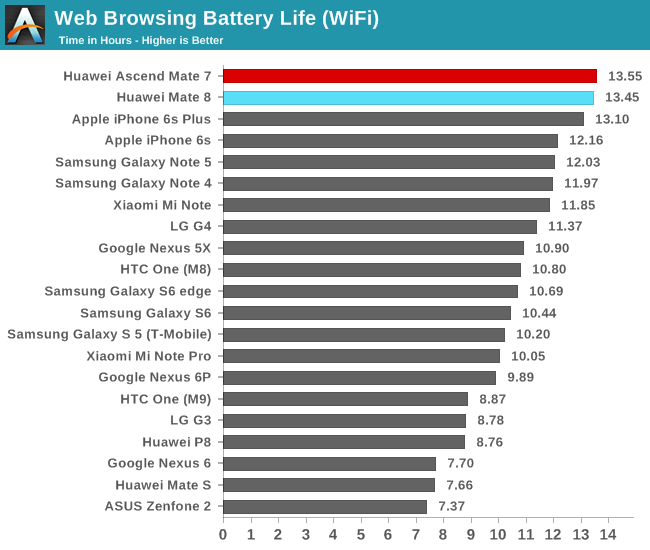
Starting off with our WiFi web-browsing test we see the Mate 8 just get short of 13.5h of battery life. The interesting comparison is here to last year’s Mate 7 as it seems the actually last just as much. This may point out that the screen efficiency measured in our display power testing was maybe correct and the Mate 8 is less efficient. Another aspect is that the Mate 8’s overall platform power consumption hasn’t seen much improvement and thus still represents a large barrier for battery life.
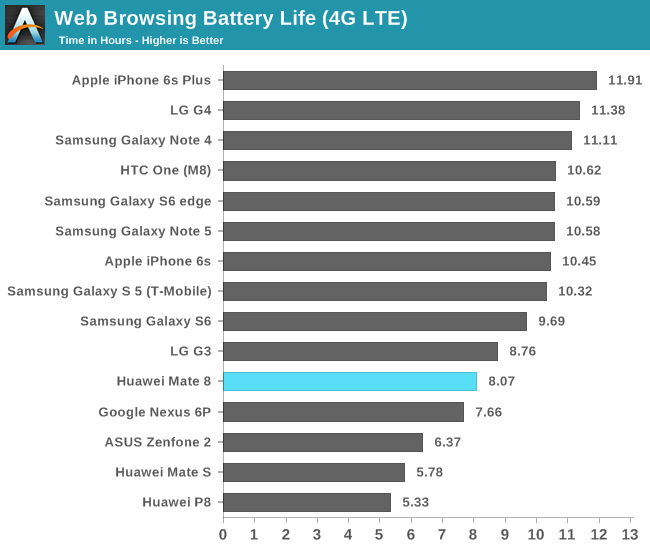
On the 4G LTE test we see that the Mate 8 loses out its advantage over the competition. Again I’m testing under rather mediocre signal conditions so it’s not a valid apples-to-apples comparison to devices reviewed by Joshua or Brandon, however when comparing it against for example such as the Nexus 6P which was tested under the same conditions we see that the Mate 8 faces a much larger battery life degradation going from the WiFi to the LTE test. The reason for this can only be that the Kirin 950’s modem and RF back-end just aren’t as efficient as Qualcomm or even Samsung’s.
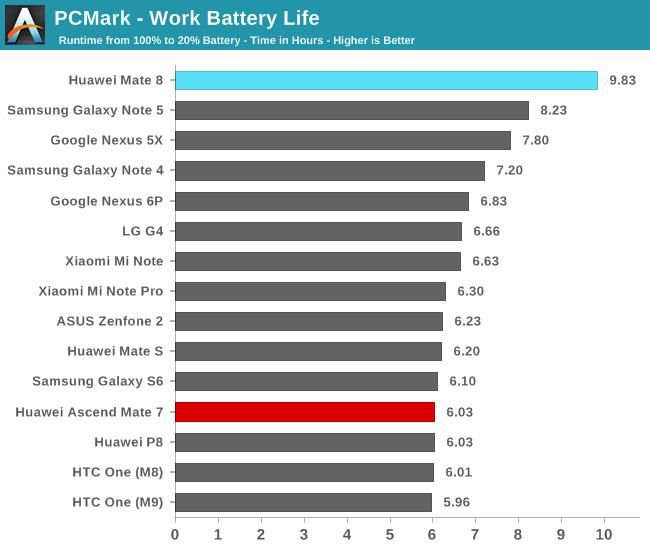
While the web-browsing tests didn’t represent a large improvement for the Mate 8, we see PCMark put the phablet as the current undisputed leader among high-performance devices. Here the difference to the Mate 7 is almost 4 hours, or around a 65% increase in battery life. The increase is most certainly linked to the new SoC’s power efficiency.
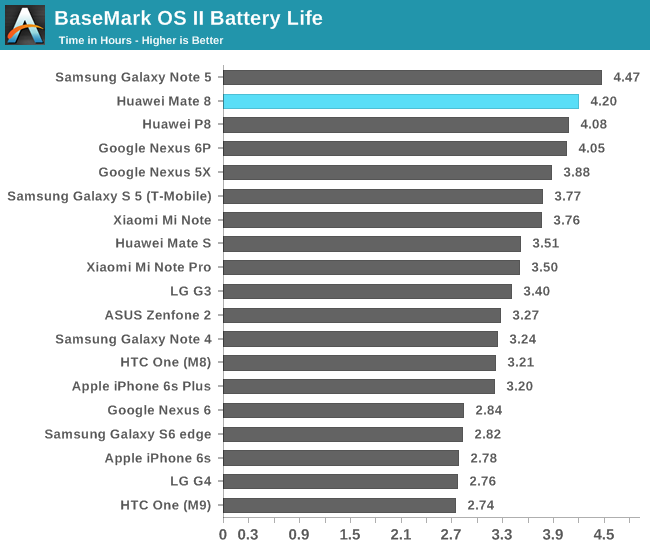
BaseMark OS II’s battery test is more of a maximum load type test that depends on the allowed maximum TDP of the phone. With a 15.2Wh battery and a runtime of 4.2h we see an average consumption of 3.6W, roughly the same amount of power that I saw that the device was able to sustain in our CPU thermal test.

Finally the GFXBench battery test shows that the Mate 8 doesn’t show very good battery life but this is a two-edged sword. As we’ve seen in the GPU section the SoC hardly throttles under heavy GPU load and thus retains its maximum performance for the duration of the test. Considering that the Mate 7 slowed throttled down to 9-10fps and the Mate 8 does not go under 40fps, it still shows that the Mate 8 is twice as efficient as the Mate 7 even though overall battery life is almost twice as short.
At 200 nits the Mate 8 averages an idle power consumption of 989mW and we saw that system load power for the T-Rex test is 3.64W. 3 hours battery runtime averages 5W of power, near the 4.6W we theorized. The small difference may be due to the overhead of actually running the on-screen test and thus also not able to show the DDIC’s savings thanks to PSR due to continuously changing screen content.
Overall I’ve been extremely impressed by the Mate 8’s battery life. In everyday usage this is the longest-lasting device I’ve had the opportunity to use. The Kirin 950’s efficiency is outstanding and is truly able to earn its place among the top for this generation. It seems the Mate 8’s limiting factors are related to the screen and general platform base power consumption, something that Huawei may be able to improve in future devices and thus get even better value out of the Kirin 950.
All being said, if you’re looking for a long-lasting device, you can’t go wrong with the Mate 8.
Charge Time
The Mate 8 advertises fast charging out of the box so that even considering it having a large 4000mAh battery, it should still be fast to fill up when in need. The stock charger is a 9V/2A (18W) unit. I’m not sure if the charging enumeration protocol is based on Quick Charge or Adaptive Fast Charging, but it was able to enable fast-charging on Samsung phones while the Mate 8 didn’t fast-charge on Samsung’s charger, meaning the Huawei charger is likely a Quick Charge unit and the Mate 8’s PMIC and voltage negotiation IC seems to only accept Quick Charge.
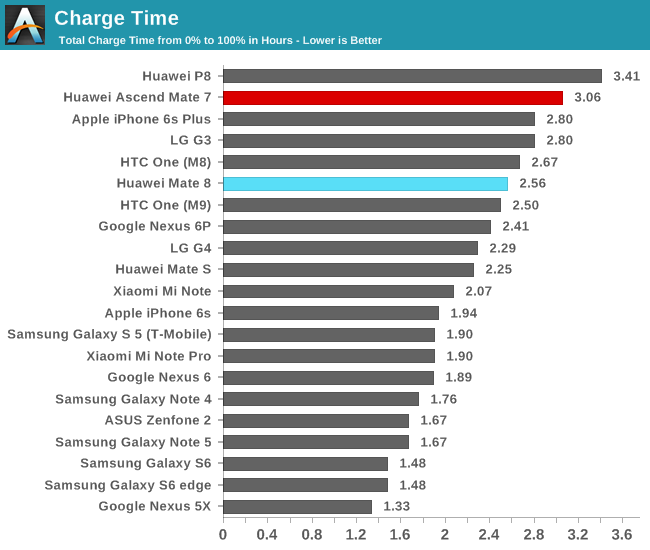
As we see in the charge graph, the Mate 8’s battery cell gets charged at up to 11.5W during the fast-charging phase, being able to reach 80% in 68 minutes around little under 40% charge for each half hour of charging. The last 20% takes up to another 70 minutes as the device switches over to trickle-charging.
While the Mate 8 ends up with total charge time of 2.56 hours, what counts is that the initial 80% of battery capacity can be charged very fast so the Mate 8 is no slouch in this metric.


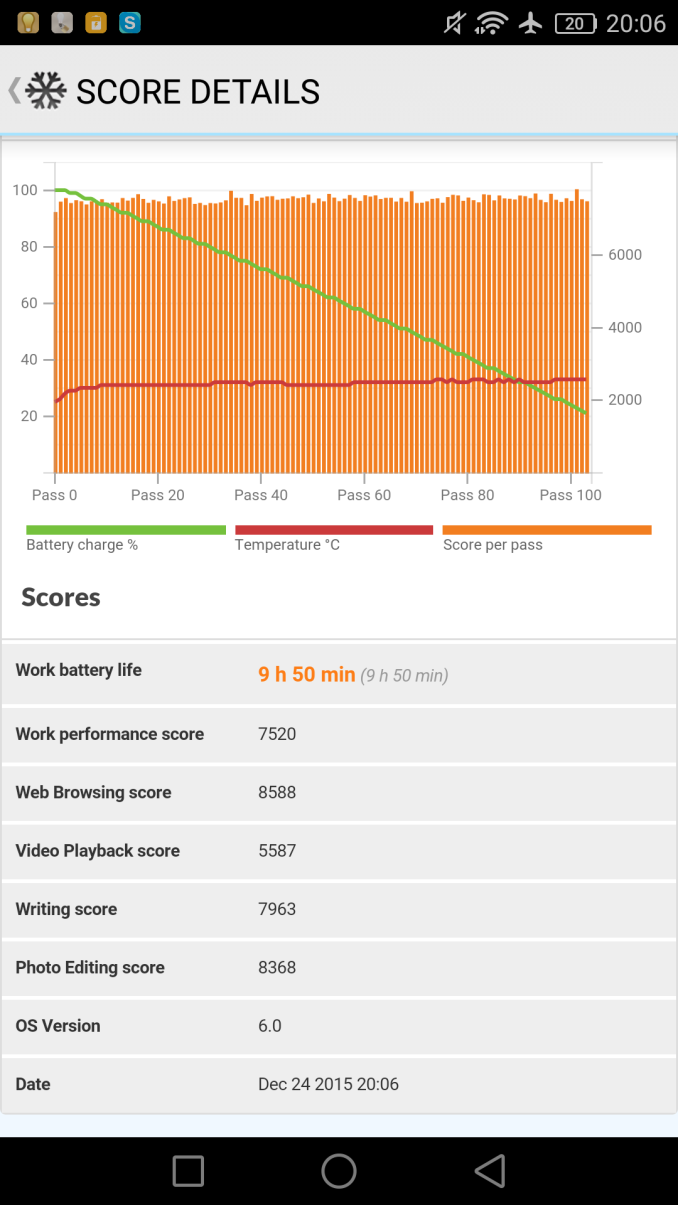
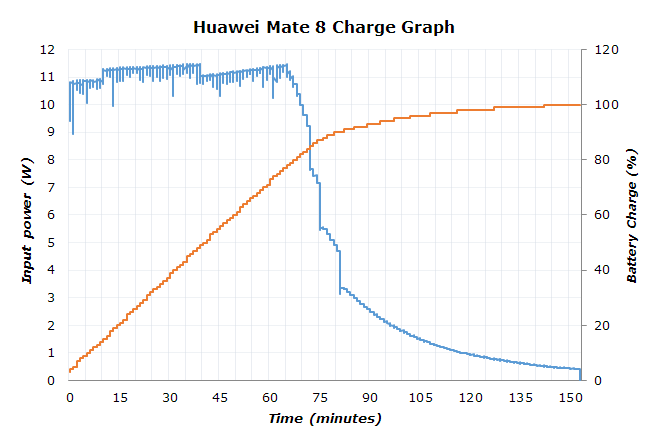








116 Comments
View All Comments
UtilityMax - Tuesday, January 5, 2016 - link
Like iPhone is not made in China..fanofanand - Wednesday, January 6, 2016 - link
My post was not in reference to the country the phone is built in (I have never owned a single apple product BTW) but rather the country that is designing this phone. The Chinese don't exactly have a reputation for quality. See the Bahamian resort in bankruptcy because of incompetent Chinese builders. As a perfect example. The long term durability of apple products are a known quantity, the same cannot be said for Huawei. My point was, you need to provide a compelling reason (price) to entice enough people to gain traction. This is like trying to go 0-60 instantly.MobiusPizza - Wednesday, January 6, 2016 - link
That is stereotyping to the extreme.If apple products are known for quality, explain antenna gate, yellowing Macbook screens and overheating Nvidia GPUs in Macbook. My point is, the country it is designed in may have historically associated with cheao quality, but doesn't mean every thing would be. For every one competent engineer in the west you can find 10 in China. The historical fact that smaller Chinese companies weren't focused on quality but more on quantity was not due to Chinese people lacking design expertise, but was driven by world demand in cheap products. Nowadays, especially big Chinese companies with stake in brand image, are much more quality focused since even local market , the more affluent Chinese general population, are increasingly demanding higher quality products. The shift is rapid.
A recent independent blinded tests for example of Japanese vs Chinese made rice cooker for example resulted in no perceived quality difference.
s.yu - Saturday, January 16, 2016 - link
Which blind test? I only noticed the laughable CCTV tests done by Chinese officials. That was a good laugh, really.ddriver - Wednesday, January 6, 2016 - link
Your view is bigoted and narrow-minded - the chinese can build lousy quality and they can build good quality - whatever the customer wants and pays for.Sure, there is that thing where a lot of companies seek to manufacture in China for the low manufacturing cost, enabling low purchase cost, thus quality is compromised for the sake of pricing.
But all in all, the chinese are capable of producing as high quality products as anyone else. It is not rocket science. Whether on not it is quality is not a subject of expertise but to whether or not you want quality.
jasonelmore - Wednesday, January 13, 2016 - link
we taught the Chinese how to make a good phone. In the case of the iphone, Apple gave them the tools, and knowledge on how to produce a quality product. it was a partnership. Apple shipped all their CNC milling machines (apple bought out the CNC Manufacturing industry for 5 years, nobody else could buy one). They are also a stake holder in many of the Foxconn factories (because they helped build them due to their volume purchase orders).Chinese have cheap labor, and many engineers, and they have towns built around electronics manufacturing. To say they did this all on their own is not true.
invinciblegod - Wednesday, January 13, 2016 - link
Exactly! It's exactly like how Japan learned how to build cars from the US companies, and now everything Japan makes can be wholly contributed to US expertise!invinciblegod - Wednesday, January 13, 2016 - link
/sarcasms.yu - Saturday, January 16, 2016 - link
lol good one.levizx - Wednesday, January 6, 2016 - link
So, who DESIGNED the "Bahamian resort"? Apparently "Chinese builders" shouldn't matter, incompetent or whatever, so that can't be "a perfect example" as you explicitly pointed out in Apple's case.